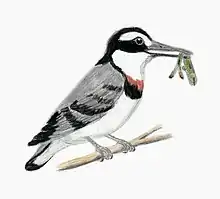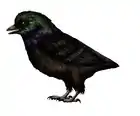| Bonapartenykus Temporal range: Late Cretaceous, | |
|---|---|
| Scientific classification | |
| Domain: | Eukaryota |
| Kingdom: | Animalia |
| Phylum: | Chordata |
| Clade: | Dinosauria |
| Clade: | Saurischia |
| Clade: | Theropoda |
| Clade: | †Patagonykinae |
| Genus: | †Bonapartenykus Agnolin et al. 2012 |
| Species: | †B. ultimus |
| Binomial name | |
| †Bonapartenykus ultimus Agnolin et al. 2012 | |
Bonapartenykus (meaning "José F. Bonaparte's claw") is a monospecific genus of alvarezsauroid dinosaur from Argentina that lived during the Late Cretaceous (Campanian-Maastrichtian) in what is now the upper Allen Formation of the Río Negro Province. The type and only species, Bonapartenykus ultimus, is known from a nearly articulated but partial skeleton that was found in close association to two incomplete eggs and several clusters of eggshells belonging to the oogenus Arriagadoolithus. Bonapartenykus was named in 2012 by Federico L. Agnolin, Jaime E. Powell, Fernando E. Novas and Martin Kundrát.[1] Bonapartenykus has an estimated length of 2.5 m (8.2 ft) and weight of 72 kg (159 lb), making it the largest member of the clade Alvarezsauroidea.
Discovery and naming

A partial skeleton of a theropod with eggs was collected in a surface of approximately 30 m2 in fluvial sandstones of the upper Allen Formation in northwestern Patagonia, Argentina.[2] The locality has also produced specimens of hadrosaurids, ankylosaurs, several titanosaur sauropods, several abelisaurids, indeterminate tetanurans, an incomplete large alvarezsaurid and a large unenlagiid.[1] The skeleton was originally reported and described by Salgado et al. (2009) as an indeterminate alvarezsaurid.[2] The specimen was later redescribed and named in 2012 by Federico L. Agnolin, Jaime E. Powell, Fernando E. Novas and Martin Kundrát. The holotype specimen, MPCA, 1290, consists of a mid-dorsal vertebra, both scapulocoracoids, left tibia and femur, left pubis articulated with the pubic peduncle of the ilium, the anterior blade of the left ilium, and two partially preserved eggs that were separated from the holotype by less than 20 cm (7.9 inches). Two specimens were referred to Bonapartenykus: MGPIFD-GR 166 and MGPIFD-GR 184, a blade of the left scapula, a left coracoid, a distal right pubis, four cervical vertebrae and a single caudal vertebra which all belong to the same individual.[1]
The eggs of Bonapartenykus were considered unique enough for them to be given a new parataxonomic name, Arriagadoolithus, which was classified in a new oofamily, the Arriagadoolithidae, so named for the owner of the site where the discovery was made.[1]
The generic name, Bonapartenykus, is derived from the Argentinean paleontologist José F. Bonaparte and the Latin word "onykus" (claw). The specific name, ultimus, is derived from the Latin word "ultimus" (latest), as it is one of the geologically youngest alvarezsaurids from South America.[1]
Description
Size and distinguishing traits

Bonapartenykus was a large alvarezsaur, measuring 2.5 m (8.2 ft) long and weighing 72 kg (159 lb).[1][3]
Agnolin et al. (2012) diagnosed Bonapartenykus based on the presence of spinopostzygapophyseal laminae that end abruptly above the postzygapophyses of the mid-dorsal vertebrae; the underside portion of the coracoid being strongly deflected towards the middle and decorated with delicate but abundant grooves as in Xixianykus; fused scapulocoracoids as in Ceratonykus; scapula with a very wide notch on the posterior margin of the bone; and a fused ilium and pubis.[1]
Postcrania

The mid-dorsal vertebrae has diapophyses and parapophyses that are worn, with the former lacking its distal ends. As in other alvarezsaurids, the centrum of the mid-dordsal vertebrae lack pleurocoels. Unlike Haplocheirus and Patagonykus, the centrum has a cranial articular surface that is deeply concave with a sharp bony margin that surrounds it, which might be procoelous. The neural spine is proportionally taller than in Mononykini, but also resembles the condition seen in basal alvarezsauroids such as Haplocheirus. As in Mononykus and Patagonykus, both the prespinal and postspinal fossae are very deep. A unique feature of Bonapartenykus is the spinopostzygapophyseal laminae ending abruptly above the rear margin of the postzygapophyses. The mid-dorsal vertebrae has neural canals that are wide and prezygapophyses that shows a subcircular contour and a shallow concavity at its caudal margin. As in Patagonykus, the parapophyses connect to the margins of the cranial articular surface through a small ridge and the diapophyses connect to the parapophyses by a deep ridge. The centrodiapophyseal lamina was craniocaudally wider than in other alvarezsaurids, based on the preserved portions. The postzygapophyses are ellipsoidal in contour in dorsal view and show a notched caudal margin. The postzygapophyses are transversely wide and craniocaudally shortened, but lacks a lateroventral projection.[1]
As in Alvarezsaurus, the scapular blade is medially deflected, unlike other alvarezsaurids that have a straight scapular blade. However, as in other alvarezsaurids, both the cranial and caudal margins are almost parallel. Along the caudal margin of the scapular blade is a well-developed notch. As in Maniraptora, Oviraptorosauria and other Alvarezsauridae, the acromion is subtriangular in shape. The glenoid fossa is oriented towards the posterior and sides, with the scapular portion being lateromedially expanded and wider than the coracoidal portion, as well as perpendicular to the main axis of the coracoid. Similar to Paraves, the ventral half of the coracoid is strongly medially flexed. The coracoid lacks a bicipital tubercle and is transversely thick at the cranial margin. The coracoidal foramen is wide and rounded in contour, and possesses several ridges near the caudal margin which may correspond to muscle attachment points. Along the side margins of the coracoid are a smooth surface towards the sides and upper side and a directed margin towards the middle and underside. This feature is similar in condition to that of Patagonykus but differs by the middle portion of the coracoid not being as strongly inflected towards and the surface of the side show only isolated and poorly developed grooves. The faintly defined ridge of Ceratonykus is very poorly and is restricted to the posterior end of the coracoid which is unlike that of Bonapartenykus. Agnolin et al. (2012) noted that the ventral half of the coracoid is deflected towards the middle, with an extremely thin medial rear that is slightly wrapping upwards which probably correlates with some kind of skin cornification, but does not correlate with a cornified sheath due to the absence of oblique neurovascular foramina. The coracoid is extremely elongate and ends at an acute end which restricted articulation with the sternum. Alvarezsaurids like Bonapartenykus may have had a flat and wide breast based on a combination of characteristics like a continuous subhorizontal surface with formed by the medial deflection of the coracoids with the sternal plate.[1]
Unlike Patagonykus, the pubic shaft of Bonapartenykus is more compressed towards the sides and narrower from front to back. As in derived alvarezsaurids, the pubic shaft lacks the caudal sulcus for the ischial articulation. The distal end of the pubic shaft possesses a small ridge on its cranial margin, which is absent in more derived alvarezsaurids, but shows a distal pubic boot on the pubis. The pubic boot appears to be rounded in side view on the rear margin. A small portion of the right ilium is preserved. The pubic pedicle is compressed towards the middle and sides. The pubic pedicle is also strongly fused with the pubis, which is a characteristic unique among alvarezsaurids, along with a reduced cuppedicus fossa. The cuppedicus fossa is shallow and elongate with a low, wide, and smooth ridge being present above it. The femoral head was separated from the greater trochanter by a cleft as indicated by the base of the cranial trochanter. The femoral head was similar in general size and proportions to Patagonykus. In lateral view, a large, sculptured bulge is present on the femur, which may correspond to muscle attachment points. The tibia is very short and robust, while the tibial shaft is bowed towards the sides. Towards the sides of the base of the cnemial crest, a small bump is present and the distal end is strongly scraped by friction or erosion.[1]
Classification
Agnolin et al. (2012) originally placed Bonapartenykus within Alvarezsauridae, within the clade Patagonykinae as sister taxon to Patagonykus.[1] Makovicky, Apesteguía and Gianechini (2012) found it to be in a polytomy with Alnashetri, Patagonykus, and a clade containing more deeply nested taxa such as Linhenykus, Mononykus and Albinykus.[4] However, Xu et al. (2018) positioned it as a basal Alvarezsauroidea, sister taxon to Patagonykus and Achillesaurus, which was also recovered by Fowler et al. (2020).[5][6] Bonapartenykus has also been recovered as sister taxon to Patagonykus and Alvarezsauridae by Qin et al. (2019), and sister taxon to only Patagonykus outside of Alvarezsauridae by Averianov & Lopatin (2022a) and Averianov & Lopatin (2022b).[7][8][9]
A phylogenetic analysis conducted by Fowler et al. (2020) is reproduced below.[6]
| Alvarezsauroidea |
| |||||||||||||||||||||||||||||||||||||||||||||||||||||||||||||||||||||||||||||||||||||||
The results of an earlier analysis by Agnolin et al. (2012) are reproduced below.[1]
| Alvarezsauridae |
| |||||||||||||||||||||||||||||||||||||||||||||||||||||||||
Paleoenvironment

Bonapartenykus is known from fluvial sandstones of the upper Allen Formation which have been dated to the Campanian to Maastrichtian stages of the Late Cretaceous period.[1] The Allen Formation represents a range of environments such as ephemeral lacustrine, aeolian and fluvial systems to coastal marine environments that developed into estuaries and tidal flats.[10] In 2015, Armas and Sánchez described the relationship of the coastal environment with wind systems of the Allen Formation and concluded the formation represents a hybrid coastal system of tidal flats with a large storm influence in some areas linked to aeolian systems.[10]
The fauna of the Allen Formation consists of the titanosaur sauropods Bonatitan,[11] Menucocelsior,[12] Panamericansaurus,[13] Rocasaurus[14] and an indeterminate species of Aeolosaurus,[15] the hadrosaurid ornithopods Bonapartesaurus,[16] Kelumapusaura,[17] Lapampasaurus[18] and Willinakaqe,[19] the nodosaurid Patagopelta,[20] the abelisaurid theropods Niebla [21] and Quilmesaurus,[22] the large unenlagiid paravian Austroraptor,[23] the avialans Lamarqueavis[24] and Limenavis,[25] the azhdarchid pterosaur Aerotitan,[26] the rhynchocephalian Lamarquesaurus,[27] and the plesiosaur Kawanectes.[28]
References
- 1 2 3 4 5 6 7 8 9 10 11 12 13 Agnolin, Federico L.; Powell, Jaime E.; Novas, Fernando E.; Kundrát, Martin (2012-06-01). "New alvarezsaurid (Dinosauria, Theropoda) from uppermost Cretaceous of north-western Patagonia with associated eggs". Cretaceous Research. 35: 33–56. doi:10.1016/j.cretres.2011.11.014. ISSN 0195-6671.
- 1 2 Salgado, Leonardo; A. Coria, Rodolfo; B. Arcucci, Andrea; M. Chiappe, Luis (2009). Farke (ed.). "Restos de Alvarezsauridae (Theropoda, Coelurosauria) en la Formación Alien (Campaniano-Maastrichtiano), en Salitral Ojo de Agua, Provincia de Río Negro, Argentina". Andean Geology. 36 (1): 67–80. doi:10.4067/S0718-71062009000100006.
- ↑ Qin, Zichuan; Qi, Zhao; Choiniere, Jonah; Clark, James M.; Benton, Michael J.; Xu, Xing (2021). "Growth and miniaturization among alvarezsauroid dinosaurs". Current Biology. 31 (16): 3705–3706. doi:10.1016/j.cub.2021.06.013. PMID 34233160. S2CID 235752037.
- ↑ Makovicky, P. J.; Apesteguía, S. N.; Gianechini, F. A. (2012). "A New Coelurosaurian Theropod from the La Buitrera Fossil Locality of Río Negro, Argentina". Fieldiana Life and Earth Sciences. 5: 90–98. doi:10.3158/2158-5520-5.1.90. S2CID 129758444.
- ↑ Xu, Xing; Choiniere, Jonah; Tan, Qingwei; Benson, Roger B.J; Clark, James; Sullivan, Corwin; Zhao, Qi; Han, Fenglu; Ma, Qingyu; He, Yiming; Wang, Shuo; Xing, Hai; Tan, Lin (2018). "Two Early Cretaceous Fossils Document Transitional Stages in Alvarezsaurian Dinosaur Evolution". Current Biology. 28 (17): 2853–2860.e3. doi:10.1016/j.cub.2018.07.057. PMID 30146153.
- 1 2 Denver W. Fowler; John P. Wilson; Elizabeth A. Freedman Fowler; Christopher R. Noto; Daniel Anduza; John R. Horner (2020). "Trierarchuncus prairiensis gen. et sp. nov., the last alvarezsaurid: Hell Creek Formation (uppermost Maastrichtian), Montana". Cretaceous Research. 116: Article 104560. doi:10.1016/j.cretres.2020.104560. S2CID 225630913.
- ↑ Qin, Zichuan; Clark, James; Choiniere, Jonah; Xu, Xing (2019). "A new alvarezsaurian theropod from the Upper Jurassic Shishugou Formation of western China". Scientific Reports. 9 (1): 11727. Bibcode:2019NatSR...911727Q. doi:10.1038/s41598-019-48148-7. PMC 6692367. PMID 31409823. S2CID 199543191.
- ↑ Alexander O. Averianov; Alexey V. Lopatin (19 February 2022). "A new alvarezsaurid theropod dinosaur from the Upper Cretaceous of Gobi Desert, Mongolia". Cretaceous Research. 134: 105168. doi:10.1016/j.cretres.2022.105168. S2CID 247000540. Retrieved 19 February 2022.
- ↑ Averianov AO, Lopatin AV (2022). "A re-appraisal of Parvicursor remotus from the Late Cretaceous of Mongolia: implications for the phylogeny and taxonomy of alvarezsaurid theropod dinosaurs". Journal of Systematic Palaeontology. 19 (16): 1097–1128. doi:10.1080/14772019.2021.2013965. S2CID 247222017.
- 1 2 Armas, Paul; Lidia Sánchez, María (2015). "Hybrid coastal edges in the Neuquén Basin (Allen Formation, Upper Cretaceous, Argentina)". Andean Geology. 42 (1): 97–113. doi:10.5027/andgeoV42n1-a06.
- ↑ Martinelli, A. and Forasiepi, A.M. (2004). "Late Cretaceous vertebrates from Bajo de Santa Rosa (Allen Formation), Rio Negro province, Argentina, with the description of a new sauropod dinosaur (Titanosauridae)". Revista del Museo Argentino de Ciencias Naturales 6(2): 257–305.
- ↑ Rolando MA, Garcia Marsà JA, Agnolín FL, Motta MJ, Rodazilla S, Novas FE (2022). "The sauropod record of Salitral Ojo del Agua: An Upper Cretaceous (Allen Formation) fossiliferous locality from northern Patagonia, Argentina". Cretaceous Research. 129: 105029. doi:10.1016/j.cretres.2021.105029. ISSN 0195-6671. S2CID 240577726.
- ↑ Calvo, J.O. & Porfiri, J.D. (2010). "Panamericansaurus schroederi gen. nov. sp. nov. Un nuevo Sauropoda (Titanosauridae-Aeolosaurini) de la Provincia del Neuquén, Cretácico Superior de Patagonia, Argentina". Brazilian Geographical Journal: Geosciences and Humanities Research Medium. 1: 100–115. Archived from the original on 2012-03-13. Retrieved 2022-03-04.
- ↑ Salgado, L. and C. Azpilicueta. (2000). Un nuevo saltasaurino (Sauropoda, Titanosauridae) de la provincia de Río Negro (Formacíon Allen, Cretácico Superior), Patagonia, Argentina. Ameghiniana 37 (3):259-264.
- ↑ Salgado, Leonardo; Coria, Rodolfo A. (1993). "El genero Aeolosaurus (Sauropoda, Titanosauridae) en la Formacion Allen (Campaniano-Maastrichtiano) de la provincia de Rio Negro, Argentina". Ameghiniana. 30 (2): 119–128.
- ↑ Cruzado-Caballero, P.; Powell, J. E. (2017). "Bonapartesaurus rionegrensis, a new hadrosaurine dinosaur from South America: implications for phylogenetic and biogeographic relations with North America". Journal of Vertebrate Paleontology. 37 (2): 1–16. doi:10.1080/02724634.2017.1289381. S2CID 90963879.
- ↑ Rozadilla, Sebastián; Brissón-Egli, Federico; Lisandro Agnolín, Federico; Aranciaga-Rolando, Alexis Mauro; Novas, Fernando Emilio (2022). "A new hadrosaurid (Dinosauria: Ornithischia) from the Late Cretaceous of northern Patagonia and the radiation of South American hadrosaurids". Journal of Systematic Palaeontology. 19 (17): 1207–1235. doi:10.1080/14772019.2021.2020917. S2CID 247122005.
- ↑ Rodolfo A. Coria, Bernardo González Riga and Silvio Casadío (2012). "Un nuevo hadrosáurido (Dinosauria, Ornithopoda) de la Formación Allen, provincia de La Pampa, Argentina". Ameghiniana. 49 (4): 552–572. doi:10.5710/AMGH.9.4.2012.487. S2CID 131521822.
- ↑ Rubén D. Juárez Valieri; José A. Haro; Lucas E. Fiorelli & Jorge O. Calvo (2010). "A new hadrosauroid (Dinosauria: Ornithopoda) from the Allen Formation (Late Cretaceous) of Patagonia, Argentina" (PDF). Revista del Museo Argentino de Ciencias Naturales. New Series. 11 (2): 217–231.
- ↑ Riguetti, Facundo; Pereda-Suberbiola, Xabier; Ponce, Denis; Salgado, Leonardo; Apesteguía, Sebastián; Rozadilla, Sebastián; Arbour, Victoria (2022-12-31). "A new small-bodied ankylosaurian dinosaur from the Upper Cretaceous of North Patagonia (Río Negro Province, Argentina)". Journal of Systematic Palaeontology. 20 (1): 2137441. doi:10.1080/14772019.2022.2137441. ISSN 1477-2019. S2CID 254212751.
- ↑ Aranciaga Rolando, Mauro; Cerroni, Mauricio A.; Garcia Marsà, Jordi A.; Agnolín, Federico L.; Motta, Matías J.; Rozadilla, Sebastián; Brisson Eglí, Federico; Novas, Fernando E. (2020-10-14). "A new medium-sized abelisaurid (Theropoda, Dinosauria) from the late cretaceous (Maastrichtian) Allen Formation of Northern Patagonia, Argentina". Journal of South American Earth Sciences. 105: 102915. doi:10.1016/j.jsames.2020.102915. hdl:11336/150468. ISSN 0895-9811. S2CID 225123133.
- ↑ Coria, R.A. (2001). "A new theropod from the Late Cretaceous of Patagonia". In Tanke, Darren H.; Carpenter, Kenneth (eds.). Mesozoic Vertebrate Life. Life of the Past. Indiana University Press. pp. 3–9. ISBN 978-0-253-33907-2.
- ↑ Novas, F. E.; Pol, D.; Canale, J. I.; Porfiri, J. D.; Calvo, J. O. (2008). "A bizarre Cretaceous theropod dinosaur from Patagonia and the evolution of Gondwanan dromaeosaurids". Proceedings of the Royal Society B: Biological Sciences. 276 (1659): 1101–7. doi:10.1098/rspb.2008.1554. ISSN 1471-2954. PMC 2679073. PMID 19129109.
- ↑ Federico L. Agnolin (2010). "An avian coracoid from the Upper Cretaceous of Patagonia, Argentina". Stvdia Geologica Salmanticensia. 46 (2): 99–119.
- ↑ Clarke and Chiappe, 2001. "A new carinate bird from the Late Cretaceous of Patagonia (Argentina)". American Museum Novitates. 3323, 1-23.
- ↑ Novas, F. E.; Kundrát, M.; Agnolín, F. L.; Ezcurra, M. D.; Ahlberg, P. E.; Iasi, M. P.; Arriagada, A.; Chafrat, P. (2012). "A New Large Pterosaur from the Late Cretaceous of Patagonia". Journal of Vertebrate Paleontology. 32 (6): 1447–1452. doi:10.1080/02724634.2012.703979. hdl:11336/98097. JSTOR 23361061. S2CID 84340520.
- ↑ Apesteguía, Sebastián; Rougier, Guillermo W. (6 September 2007). "A Late Campanian Sphenodontid Maxilla from Northern Patagonia" (PDF). American Museum Novitates (3581): 1. doi:10.1206/0003-0082(2007)3581[1:ALCSMF]2.0.CO;2. hdl:2246/5874.
- ↑ O'Gorman, J.P. (2016). "A Small Body Sized Non-Aristonectine Elasmosaurid (Sauropterygia, Plesiosauria) from the Late Cretaceous of Patagonia with Comments on the Relationships of the Patagonian and Antarctic Elasmosaurids". Ameghiniana. 53 (3): 245–268. doi:10.5710/AMGH.29.11.2015.2928. S2CID 133139689.

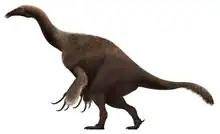

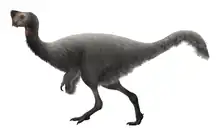
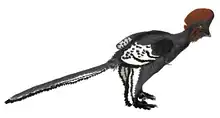


.png.webp)

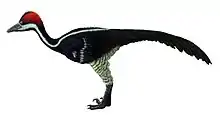
.jpg.webp)

